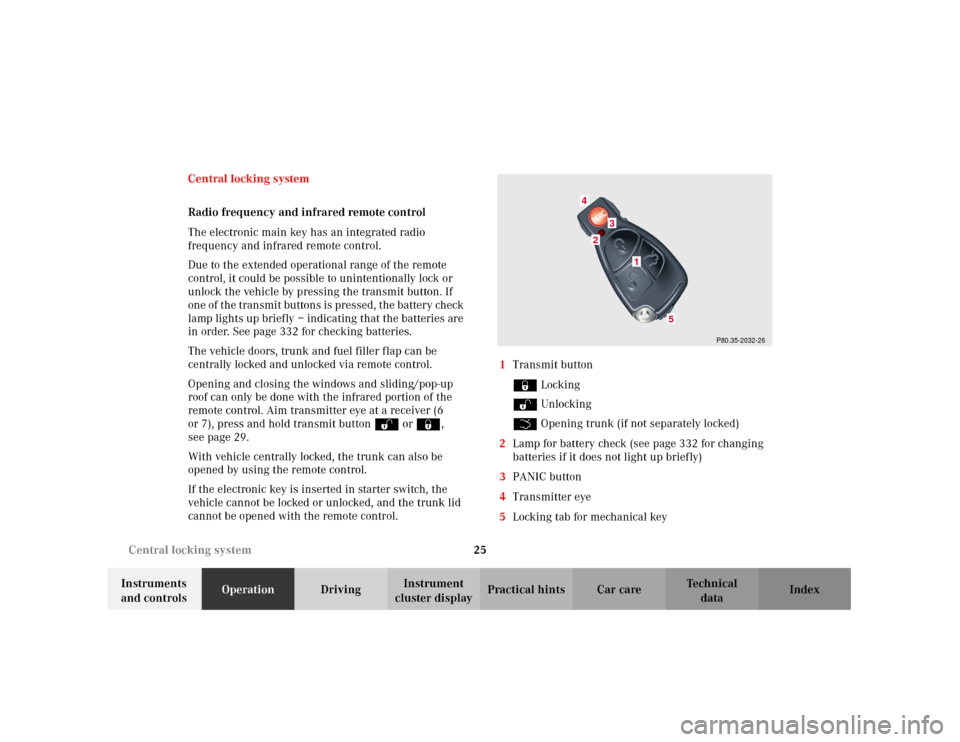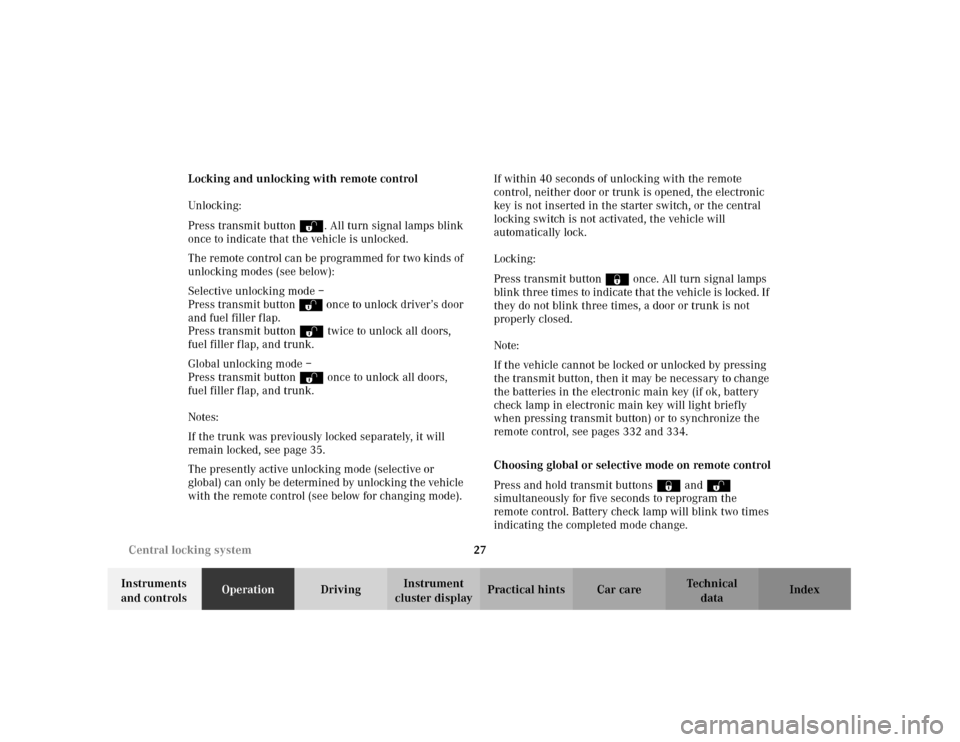2001 MERCEDES-BENZ C320 fuel
[x] Cancel search: fuelPage 6 of 381

Contents
DrivingControl and operation of radio
transmitters ............................... 218
The first 1 000 miles
(1 500 km) ................................. 219
Maintenance ................................... 219
Tele Aid ...........................................220
Catalytic converter ........................228
Emission control ............................229
Starter switch .................................230
Starting and turning
off the engine ............................232
Manual transmission ....................233
Automatic transmission ...............234
Parking brake .................................243
Driving instructions ......................244
Drive sensibly – Save Fuel ........244
Drinking and driving .................244
Pedals ...........................................244Power assistance ........................ 245
Brakes .......................................... 245
Driving off ................................... 246
Parking ........................................ 246
Tires ............................................. 247
Snow chains ............................... 250
Winter driving
instructions ................................ 250
Deep water .................................. 252
Passenger compartment ........... 253
Traveling abroad ........................ 253
Cruise control ................................ 254
Brake assist system (BAS) ............ 257
Antilock brake system
(ABS) .......................................... 258
Electronic stability program
(ESP) ........................................... 260
What you should know at the gas
station ......................................... 264
Check regularly and before a long
trip .............................................. 266
Instrument cluster displayMalfunction and indicator lamps in
the instrument cluster .............268
On-board diagnostic system .........268
Check engine malfunction
indicator lamp .............................268
Brake warning lamp ..................270
Supplemental restraint system
(SRS) indicator lamp .................. 271
Fuel reserve warning ................. 271
ABS malfunction
indicator lamp .............................272
Electronic stability program
(ESP) — warning lamp ...............273
Seat belt nonusage
warning lamp ............................273
Malfunction and indicator lamp in
the center console .....................273
AIRBAG OFF indicator lamp .....273
Page 7 of 381

Contents
Malfunction and warning messages
in the multifunction display ... 274
DISPLAY DEFECTIVE ................275
BATTERY / ALTERNATOR ........ 276
ANTILOCK BRAKE SYSTEM .....277
BRAKE ASSIST ...........................277
BRAKE LINING WEAR ..............278
BRAKE FLUID .............................278
PARKING BRAKE .......................279
SEAT BELT SYSTEM ...................279
ELEC. STABIL. PROG.
(Electronic stability program) ..280
COOLANT (coolant level) .......... 281
COOLANT
(coolant temperature) ................282ENGINE OIL LEVEL ................... 283
LIGHTING SYSTEM ................... 284
LIGHT SENSOR .......................... 286
DOOR ........................................... 286
TRUNK OPEN ............................. 287
HOOD ........................................... 287
TELEPHONE – FUNCTION ....... 288
TELE AID ..................................... 288
WASHER FLUID ......................... 289
RESTRAINT SYSTEM ................ 290
KEY .............................................. 290
FUEL RESERVE .......................... 291
UNDERVOLTAGE ....................... 291
STEER. WHEEL ADJUST. .......... 292
ENTRANCE POSITION .............. 292
Practical hintsFirst aid kit .....................................294
Stowing things in the vehicle ......294
Fuses ................................................295
Hood .................................................297
Checking engine oil level .............300
Automatic transmission fluid
level ............................................. 301
Coolant level ................................... 301
Adding coolant ...........................302
Windshield and headlamp washer
system .........................................302
Spare wheel, vehicle tools, storage
compartment .............................304
Vehicle jack .....................................305
Page 8 of 381

ContentsWheels .............................................306
Tire replacement ........................306
Rotating wheels ..........................307
Spare wheel ....................................308
Changing wheels ...........................309
Tire inflation pressure .................. 315
Battery ............................................. 316
Jump starting .................................. 318
Towing the vehicle ......................... 321
Transmission selector lever,
manually unlocking ...................325
Exterior lamps ................................326
Replacing bulbs ..........................326
Trunk lamp ..................................... 331
Changing batteries in the electronic
main key .....................................332Synchronizing remote
control ......................................... 334
Emergency engine shut-down ..... 334
Fuel filler flap, manual release ... 335
Replacing wiper blade insert ...... 337
Roof rack ......................................... 338
Vehicle careCleaning and care of
the vehicle ................................. 340
Power washer ............................. 341
Tar stains .................................... 341
Paintwork, painted body
components ................................ 341
Engine cleaning ......................... 342
Vehicle washing ......................... 342Ornamental moldings ................343
Headlamps, taillamps, turn signal
lenses ...........................................343
Window cleaning .......................343
Wiper blade .................................343
Light alloy wheels ......................344
Instrument cluster .....................344
Steering wheel and gear selector
lever ..............................................344
Cup holder ...................................344
Seat belts .....................................345
Headliner and shelf below rear
window ........................................345
Leather upholstery .....................345
Hard plastic trim items .............345
Plastic and rubber parts ............345
Page 9 of 381

Contents
Technical dataSpare parts service ........................348
Warranty coverage .........................348
Identification labels .......................349
Layout of poly-V-belt drive ............350
Technical data ................................ 351
Fuels, coolants, lubricants etc. -
capacities ...................................355
Engine oils ......................................357Engine oil additives ...................... 357
Air conditioner refrigerant .......... 357
Brake fluid ...................................... 357
Premium unleaded gasoline ........ 358
Fuel requirements ........................ 358
Gasoline additives ......................... 359
Coolants .......................................... 359
Consumer information ................. 361
Uniform tire quality grading ....... 361
IndexIndex .................................................364
Page 14 of 381

5 IntroductionOperating your vehicle outside the USA or Canada
If you plan to operate your vehicle in foreign countries, please be aware that:
•Service facilities or replacement parts may not be readily available,
•unleaded gasoline for vehicles with catalytic converters may not be available; the use of leaded fuels will damage
the catalysts,
•gasoline may have a considerably lower octane rating, and improper fuel can cause engine damage.
Certain Mercedes-Benz models are available for delivery in Europe under our European Delivery Program. For details,
consult your authorized Mercedes-Benz Center or write to:
In the USA: In Canada:
Mercedes-Benz USA, LLC
European Delivery Department
One Mercedes Drive
Montvale, NJ 07645-0350Mercedes-Benz Canada, Inc.
European Delivery Department
849 Eglinton Avenue East
Toronto, Ontario M4G 2L5
Page 16 of 381

7 IntroductionWhere to find it
The Operator’s Manual is divided into eight sections:
• Instruments and controls: An overview of all the controls that can be operated from the driver’s seat.
•Operation: Information on the vehicle’s equipment and its operation.
•Driving: Important information on driving.
• Instrument cluster display: Displays and indicator lamps on the instrument cluster with brief instructions.
•Practical hints: Assistance and instructions in the event of an emergency.
• Car care: Instructions on caring for your vehicle.
• Technical data: All the important technical data for your vehicle as well as consumer information such as fuels,
coolants, lubricants etc. is contained here.
•Index: Key terms to help you find a topic quickly.
Other documents may also be supplied, depending on your vehicle’s equipment.
Explanation of color used:
Warning notices for the protection of yourself and
others appear on red background.
Page 34 of 381

25 Central locking system
Te ch n i c a l
data Instruments
and controlsOperationDrivingInstrument
cluster displayPractical hints Car care Index Central locking system
Radio frequency and infrared remote control
The electronic main key has an integrated radio
frequency and infrared remote control.
Due to the extended operational range of the remote
control, it could be possible to unintentionally lock or
unlock the vehicle by pressing the transmit button. If
one of the transmit buttons is pressed, the battery check
lamp lights up brief ly – indicating that the batteries are
in order. See page 332 for checking batteries.
The vehicle doors, trunk and fuel filler flap can be
centrally locked and unlocked via remote control.
Opening and closing the windows and sliding/pop-up
roof can only be done with the infrared portion of the
remote control. Aim transmitter eye at a receiver (6
or 7), press and hold transmit button Œ or ‹,
seepage29.
With vehicle centrally locked, the trunk can also be
opened by using the remote control.
If the electronic key is inserted in starter switch, the
vehicle cannot be locked or unlocked, and the trunk lid
cannot be opened with the remote control.1Transmit button
‹ Locking
ΠUnlocking
Š Opening trunk (if not separately locked)
2Lamp for battery check (see page 332 for changing
batteries if it does not light up briefly)
3PANIC button
4Transmitter eye
5Locking tab for mechanical key
P80.35-2032-26
24
3
5
1
Page 36 of 381

27 Central locking system
Te ch n i c a l
data Instruments
and controlsOperationDrivingInstrument
cluster displayPractical hints Car care Index Locking and unlocking with remote control
Unlocking:
Press transmit button Œ. All turn signal lamps blink
once to indicate that the vehicle is unlocked.
The remote control can be programmed for two kinds of
unlocking modes (see below):
Selective unlocking mode –
Press transmit button Œ once to unlock driver’s door
and fuel filler flap.
Press transmit button Πtwice to unlock all doors,
fuel filler flap, and trunk.
Global unlocking mode –
Press transmit button Πonce to unlock all doors,
fuel filler flap, and trunk.
Notes:
If the trunk was previously locked separately, it will
remain locked, see page 35.
The presently active unlocking mode (selective or
global) can only be determined by unlocking the vehicle
with the remote control (see below for changing mode).If within 40 seconds of unlocking with the remote
control, neither door or trunk is opened, the electronic
key is not inserted in the starter switch, or the central
locking switch is not activated, the vehicle will
automatically lock.
Locking:
Press transmit button ‹ once. All turn signal lamps
blink three times to indicate that the vehicle is locked. If
they do not blink three times, a door or trunk is not
properly closed.
Note:
If the vehicle cannot be locked or unlocked by pressing
the transmit button, then it may be necessary to change
the batteries in the electronic main key (if ok, battery
check lamp in electronic main key will light briefly
when pressing transmit button) or to synchronize the
remote control, see pages 332 and 334.
Choosing global or selective mode on remote control
Press and hold transmit buttons‹ andŒ
simultaneously for five seconds to reprogram the
remote control. Battery check lamp will blink two times
indicating the completed mode change.